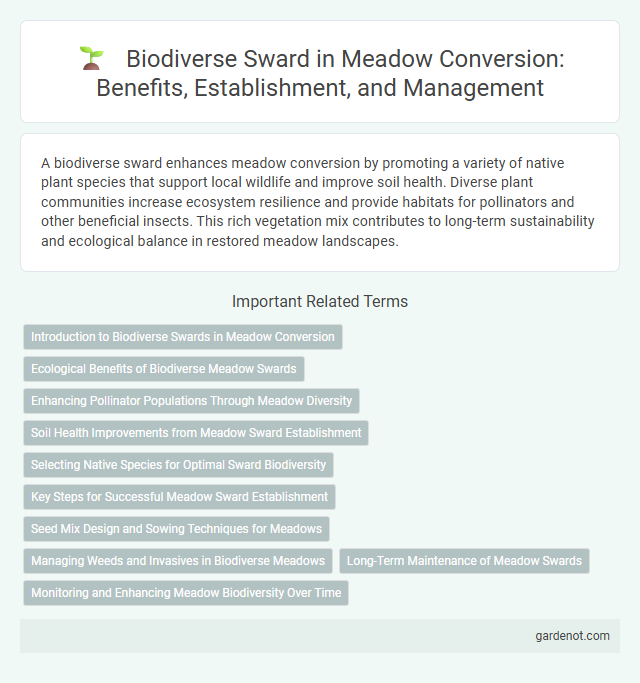A biodiverse sward enhances meadow conversion by promoting a variety of native plant species that support local wildlife and improve soil health. Diverse plant communities increase ecosystem resilience and provide habitats for pollinators and other beneficial insects. This rich vegetation mix contributes to long-term sustainability and ecological balance in restored meadow landscapes.
Introduction to Biodiverse Swards in Meadow Conversion
Biodiverse swards are vital in meadow conversion, consisting of a rich mix of native grasses, wildflowers, and legumes that support pollinators and enhance soil health. Establishing these swards promotes ecosystem resilience by increasing habitat complexity and fostering nutrient cycling. Selecting appropriate species based on soil type and local climate ensures sustainable growth and maximizes biodiversity benefits.
Ecological Benefits of Biodiverse Meadow Swards
Biodiverse meadow swards support a wide array of flora and fauna, enhancing ecosystem resilience by providing varied habitats for pollinators, birds, and soil organisms. These diverse plant communities improve soil structure and nutrient cycling, promoting long-term soil health and reducing erosion. The increased genetic variety within these swards also bolsters resistance to pests and diseases, contributing to sustainable ecosystem function.
Enhancing Pollinator Populations Through Meadow Diversity
Biodiverse swards in meadow conversion support a rich variety of flowering plants that provide continuous nectar and pollen resources, crucial for pollinator populations such as bees, butterflies, and hoverflies. Enhancing plant species diversity within meadows improves habitat complexity, shelter, and forage availability, directly boosting pollinator abundance and health. Diverse meadows contribute to resilient ecosystems by sustaining pollination services essential for agricultural productivity and native flora reproduction.
Soil Health Improvements from Meadow Sward Establishment
Establishing a biodiverse meadow sward significantly enhances soil health by increasing organic matter content and promoting robust microbial activity. Diverse plant species contribute varied root structures that improve soil aeration, water infiltration, and nutrient cycling. These improvements lead to greater soil fertility, resilience against erosion, and long-term ecosystem stability.
Selecting Native Species for Optimal Sward Biodiversity
Selecting native species for meadow conversion ensures a biodiverse sward by promoting ecological balance and supporting local wildlife. Native plants adapt to regional soil and climate conditions, enhancing sward resilience and reducing maintenance needs. Incorporating a mix of grasses, wildflowers, and legumes maximizes habitat variety and seasonal interest, fostering a robust and sustainable meadow ecosystem.
Key Steps for Successful Meadow Sward Establishment
Selecting a diverse mix of native wildflower and grass species tailored to local soil and climate conditions ensures a biodiverse sward that supports pollinators and wildlife. Soil preparation involves minimal disturbance and avoidance of nutrient-rich fertilizers to favor wildflower establishment over aggressive grasses. Ongoing management through adaptive mowing regimes and seasonal monitoring enhances plant diversity and resilience in successful meadow sward establishment.
Seed Mix Design and Sowing Techniques for Meadows
Biodiverse sward establishment relies on carefully designed seed mixes that include a variety of native grasses and wildflowers tailored to local soil and climate conditions, promoting ecosystem resilience and habitat diversity. Effective sowing techniques, such as precision broadcast seeding and seedbed preparation, ensure optimal seed-to-soil contact and uniform germination, enhancing sward density and species richness. Incorporating species with staggered flowering periods and varying growth habits supports pollinator populations and long-term meadow sustainability.
Managing Weeds and Invasives in Biodiverse Meadows
Effective management of weeds and invasive species in biodiverse swards is crucial to maintaining ecological balance and promoting native flora. Targeted removal techniques, such as selective cutting and spot herbicide application, minimize disruption to beneficial plants and support habitat diversity. Regular monitoring ensures early detection and control of invasive species, preventing their dominance and preserving meadow biodiversity.
Long-Term Maintenance of Meadow Swards
Biodiverse swards support long-term meadow resilience by enhancing plant species richness and soil health, essential for sustainable ecosystem services. Regular management practices such as seasonal mowing and selective grazing maintain species balance, preventing dominance of competitive grasses. Maintaining these swards promotes pollinator habitats and carbon sequestration, contributing to biodiversity conservation and climate mitigation.
Monitoring and Enhancing Meadow Biodiversity Over Time
Monitoring and enhancing meadow biodiversity over time involves regular assessments of plant species composition and abundance within biodiverse swards. Employing tools like quadrat sampling and remote sensing helps track ecological changes and identify invasive species. Adaptive management strategies, including targeted mowing and seed introduction, support the resilience and richness of meadow ecosystems.
Biodiverse sward Infographic

 gardenot.com
gardenot.com